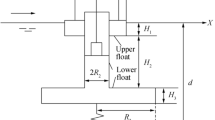Abstract
Wave-energy converters (WECs) usually comprise a wave-energy absorber and a reaction supporter on which the wave forces can work. The reaction supporter can promote the accumulation and conversion of wave energy, making WECs more feasible. In this article, we propose a novel WEC structure consisting of a submerged disk and a coaxially moon-pool paddock. In this structure, the disk functioned as the energy absorber and the paddock functioned as the corbelled and wave-energy accumulation device. The power take-off system comprises a linear damper and a spring, which can be activated by the heaving motion of the bodies. The heaving motion equation of the corresponding system in frequency domain is given according to the literature. The optimal reactive spring stiffness and resistive damping coefficients are determined by their vibration characteristics. Furthermore, the corresponding oscillation amplitudes and the wave-energy absorption capture width ratios are also determined approximately. Based upon eigenfunction expansion matching method in the linear potential theory, the analytical expressions for the diffraction and radiation are obtained. In addition, this research proposed the theoretical expressions for added mass, damping coefficient, and exciting force. Finally, the effects of the geometrical parameters and submerged depth of the moon-pool paddock on the wave-energy conversion are illustrated and discussed. It is found that the moon-pool paddock can assist accumulate wave energy and increase the energy conversion. The results also demonstrate the importance of tuning the geometries of the paddock to maximize total energy capture.












Similar content being viewed by others
References
Ohneda H, Igarashi S et al. (1991) Construction procedure of a wave power extracting caisson breakwater. In: Proceedings of the 3rd symposium on ocean energy utilization, pp 171–9
Mavrakos SA (2005) Hydrodynamic coefficients in heave of two concentric surface piercing truncated circular cylinders. Appl Ocean Res 26:84–97
Falcão AFO (2008) Phase control through load control of oscillating-body wave energy converters with hydraulic PTO system. Ocean Eng 35:358–366
Beirbão P, Valerio D, Sada Costa J (2007) Linear model identification of the Archimedes Wave Swing. In: International conference on power engineering—energy and electrical drives proceedings, NO.4380214, pp 660–665
Mavrakos SA, Katsaounis GM (2009) Effects of floaters’ hydrodynamics on the performance of tightly moored wave energy converters. IET Renew Power Gen 4(6):531–544
Mavrakos SA, Katsaounis GM, Apostolidis MS (2009) Effects of floaters’ geometry on the performance characteristics of tightly moored wave energy converters. In: Proceedings of the 28th international conference on ocean offshore arctic engineering, ASME, Honolulu, Hawaii, Paper No OMAE 2009 pp 80133
Mehdi Nazari H, Ghassemi M, Ghiasi, Mesbah Sayehbani (2013) Design of the point absorber wave energy converter for Assaluyeh Port. Iran J Energy Environ 4(2):130–135
Thomas Soulard M, Alves, António S (2009) Force reacting principle applied to a heave point absorber wave energy converter. In: The 19th international offshore and polar engineering conference, Osaka, pp 21–26
Jamie Goggins WF (2014) Shape optimization of floating wave energy converters for a specified wave energy spectrum. Renew Energy 71:208–220
Troch P, Stratigaki V, Stallard T, Forehand D, Folley M, Kofoed JP et al (2013) Physical modelling of an array of 25 heaving wave energy converters to quantify variation of response and wave conditions. Paper presented at 10th European wave and tidal energy conference, Aalborg, Denmark, pp 1–9
Konispoliatis DN, Mavrakos SA (2016) Hydrodynamic analysis of an array of interacting free-floating oscillating water column (OWC׳s) devices. Ocean Eng 111:179–197
Stansby P, Moreno EC, Stallard T et al (2015) Three-float broad-band resonant line absorber with surge for wave energy conversion. Renew Energy 78:132–140
Harnois V, Weller SD, Johanning L et al (2015) Numerical model validation for mooring systems: Method and application for wave energy converters. Renew Energy 75:869–887
Falcão AF, Henriques JCC (2015) Effect of non-ideal power take-off efficiency on performance of single- and two-body reactively controlled wave energy converters. J Ocean Eng Mar Energy 1(3):1–14
Muliawan MJ, Gao Z, Moan T (2013) Analysis of a two-body floating wave energy converter with particular focus on the effects of power take-off and mooring systems on energy capture. J Offshore Mech Arct Eng135(3):317–328
Fitzgerald J, Bergdahl L (2008) Including moorings in the assessment of a generic offshore energy converter: a frequency domain approach. Mar Struct 21:23–46
Margheritini L, Vicinanza D, Frigaard P (2009) SSG wave energy converter: design, reliability and hydraulic performance of an innovative overtopping device. Renew Energy 34(5):1371–1380
Jain R (1980) A simple method of calculating the equivalent stiffnesses in mooring cables. Appl Ocean Res 2(3):139–42
Garrett CJR (1971) Waves forces on a circular dock. J Fluid Mech 46:129–39
Chen XB, Liu HX, Duan WY (2015) Semi-analytical solutions to wave diffraction of cylindrical structures with a moonpool with a restricted entrance. J Eng Math 90(1):51–66
Loukogeorgaki E, Angelides DC (2005) Stiffness of mooring lines and performance of floating breakwater in three dimensions. Appl Ocean Res 27:187–208
Acknowledgements
This paper is financially supported by the National Natural Science Foundation (Nos. 5171101175 and 51509048) and High-Tech Ship Research Projects-Floating Support Platform Sponsored by the Ministry of Industry and Information Technology (MIIT) of China.
Author information
Authors and Affiliations
Corresponding authors
Appendix A
Appendix A
The expression for known function Z 0(·), Z n (·), and ε λ is given by
The known functions Q(·) in diffraction and radiation potentials in sub-domain III (1,2) are given by
The known functions Ω(·) in diffraction and radiation potentials in each sub-domain are given by
The above generalized d denotes the vertical distance between seabed and bottom of the hull in each sub-domain.
About this article
Cite this article
Zhang, Z.Y., Liu, H.X., Zhang, L. et al. Study on the performance analysis and optimization of funnel concept in wave-energy conversion. J Mar Sci Technol 23, 696–705 (2018). https://doi.org/10.1007/s00773-017-0504-4
Received:
Accepted:
Published:
Issue Date:
DOI: https://doi.org/10.1007/s00773-017-0504-4



